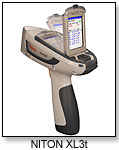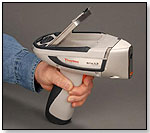
April 18, 2024

November 2007 | Vol. VI - No. 11
NITON Gives Lead Testing a Hand
Thermo Fisher’s Analyzer Tests to Keep Toys Safe
| “It can be used … anywhere throughout the manufacturing and supply chain.” — Jon Shein, Thermo Fisher Scientific |
 It was after a young boy fatally swallowed a lead-tainted charm in 2006 that Thermo Fisher Scientific began screening toys for lead — expanding its specialization in analytical science to a new industry.
It was after a young boy fatally swallowed a lead-tainted charm in 2006 that Thermo Fisher Scientific began screening toys for lead — expanding its specialization in analytical science to a new industry.
Six or seven years ago, Jon Shein, director of global marketing for the NITON Analyzers Business Unit, began taking instruments home to test his own child’s toys, he told TDmonthly Magazine. And now, toy manufacturers, retailers and even the U.S. Consumer Product Safety Commission are jumping on board to use the company’s hand-held Thermo Scientific NITON® x-ray fluorescence (XRF) analyzers to screen products for lead and other toxic metals.
“We have had significant response to our efforts in the toys and consumer goods market since the summer,” Shein said in October of heightened interest since the barrage of toy recalls by Mattel and other manufacturers.
October of heightened interest since the barrage of toy recalls by Mattel and other manufacturers.
BUILDING A BUSINESS
The original NITON LLC, sold in 2005 to what is now Thermo Fisher Scientific, was founded in 1987 by Dr. Lee Grodzins, an MIT physics professor.
By 1994, thanks to two rounds of funding from the Environmental Protection Agency and three subsequent rounds of Department of Energy funding, Dr. Grodzins and his colleagues had developed the initial NITON analyzer, which was used to measure lead content in house paint. Additional innovations included measuring lead in soil and dust, as well as testing for other toxic elements.
“We’re able to draw on well over a decade of experience in the measurement of lead in various forms, and are applying that knowledge to the challenge of measuring lead in toys and other consumer products,” Shein told TDmonthly.
The application is well underway, as Thermo Fisher Scientific has worked directly with toy manufacturers for the past year, educating them on “how [the technology] can be used to supplement existing lead-screening methods,” he added.
MAKING TESTING QUICKER
Supplementation is key, Shein indicated, explaining that typical lab tests require scraping paint from the surface of a toy, putting the paint in an acid solution, diluting it, and then allowing an inductively coupled plasma-optical emission spectrometer (ICP-OES) to read the levels of lead.
The NITON XRF doesn’t nullify the need for these time-consuming procedures, but rather lets companies screen a large number of products in a short amount of time — perhaps 10 to 20 products in an hour if screening several areas of the same toy — and decide which ones should be submitted to a third-party testing center for further examination.
Since measurements are non-destructive, Shein emphasized, manufacturers can screen the actual toys that are shipped to children, not just “representative” samples that are analyzed in a lab. Companies can “use it as a screening device, to verify that certain toys or components of toys are, in fact, lead free,” he told TDmonthly.
 PUTTING NITON TO WORK
PUTTING NITON TO WORK
The portable Thermo Scientific NITON XRF analyzer can detect concentrations of lead and other metals at levels well below the legal limit of 600 ppm in dry paint. It also provides quick measurement, demonstrated by numerical data and a pass/fail indication on screen, the most recent of which has an angled display for ease of use.
A company based in Europe with warehouses in California, Illinois and Texas, Shein illustrated, could easily take the analyzer to any of those destinations, as well as to a factory in China for inspection.
Better yet, “it can be used by somebody with comparatively little training and education,” Shein pointed out. “It can be used by people in quality control, shipping and receiving — anywhere throughout the manufacturing and supply chain — with minimal interruption of work flow.”
Thermo Fisher Scientific offers rental options, starting at $1,000 per week in the United States, for companies that want to try out the instrument or aren’t sure how many they need. Purchase prices range from $25,000 to nearly $50,000 depending on the model and accessories.
The company has also provided a free series of webinars specific to the toy and consumer goods market, discussing the hazards of lead and the usage of the NITON analyzer. They are designed to prep potential clients before talking with a sales rep. “People are bringing into each webinar their real-life examples,” Shein said.
Of course, beyond the analytics, the bottom line is the safety of products in real life. “While the vast majority of toys don’t have lead,” Shein said, “the NITON analyzer allows toy makers to confirm that their products are OK to ship in seconds.”
“When this equipment is used by people in the toy industry,” he concluded, “it will greatly reduce the likelihood that lead in toys will end up on store shelves or in a child’s hands.”
UPDATE
Thermo Fisher Scientific continues to improve the NITON. In April 2008, they announced the release of a major software upgrade for its handheld XRF analyzers. The upgrades include TestAll Technology that automatically selects the correct analytical mode for consumer goods analysis; a simplified Chinese language option in addition to the current English, French, German, Spanish and Portuguese offerings, and many other features. These new capabilities are available at no extra charge for all NITON XL3 Series XRF Analyzers.
Read more about the NITON.
Copyright © 2024 TDmonthly®, a division of TOYDIRECTORY.com®,
Inc.



 It was after a young boy fatally swallowed a lead-tainted charm in 2006 that Thermo Fisher Scientific began screening toys for lead — expanding its specialization in analytical science to a new industry.
It was after a young boy fatally swallowed a lead-tainted charm in 2006 that Thermo Fisher Scientific began screening toys for lead — expanding its specialization in analytical science to a new industry. October of heightened interest since the barrage of toy recalls by Mattel and other manufacturers.
October of heightened interest since the barrage of toy recalls by Mattel and other manufacturers. PUTTING NITON TO WORK
PUTTING NITON TO WORK